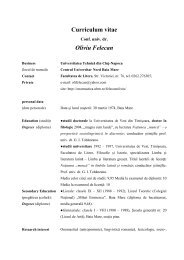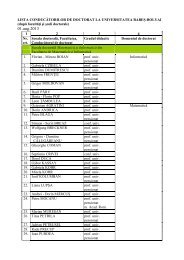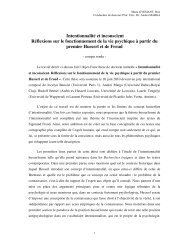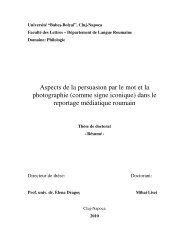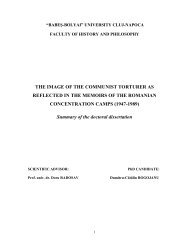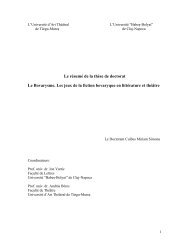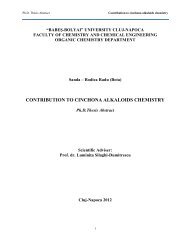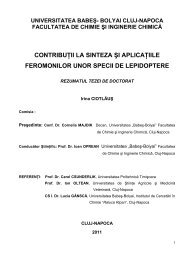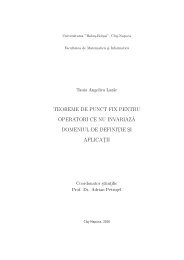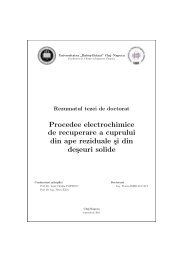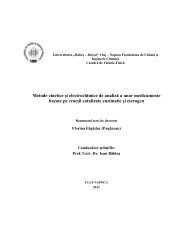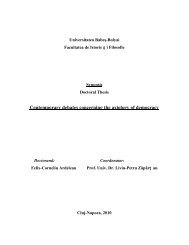ADVERBIAL RESTRUCTURING IN CONTEMPORARY ... - Doctorat
ADVERBIAL RESTRUCTURING IN CONTEMPORARY ... - Doctorat
ADVERBIAL RESTRUCTURING IN CONTEMPORARY ... - Doctorat
Create successful ePaper yourself
Turn your PDF publications into a flip-book with our unique Google optimized e-Paper software.
<strong>ADVERBIAL</strong> <strong>RESTRUCTUR<strong>IN</strong>G</strong> <strong>IN</strong> <strong>CONTEMPORARY</strong> ROMANIAN<br />
Babeş-Bolyai University, Cluj-Napoca<br />
Scientific advisor: Prof. univ. dr. G. G. Neamţu<br />
Candidate: drd. Melania Duma<br />
TABLE OF CONTENTS & ABSTRACT<br />
<strong>IN</strong>TRODUCTION<br />
TABLE OF CONTENTS<br />
CHAPTER 1 Methodology<br />
1.1. Introduction<br />
1.2. Qualitative Methods. Argument Development<br />
1.3. Quantitative Methods. The Corpus and the Questionnaire – means of investigation<br />
1.3.1. Generalities. Data Collection<br />
1.3.2. Participants<br />
1.3.3. The Questionnaire<br />
1.4. Conclusions<br />
CHAPTER 2 Theoretical background<br />
2.1. Introduction<br />
2.2. General notes on the formal approach to syntax<br />
2.3. Chomskyan Minimalism<br />
2.4. Distributed Morphology<br />
2.5. Mixed Approaches<br />
2.6. Theoretical Proposal<br />
2.7. Conclusions<br />
1
CHAPTER 3 Descriptive Data. Preliminary analysis<br />
3.1. Introduction<br />
3.2. On syntactic functions and the EAO subordinating elements<br />
3.3. EAO constructions which integrate predication<br />
3.4. The Subject<br />
3.5. The interaction between subordinating elements and arguments<br />
3.5.1. Prepositions. Adverbs<br />
3.5.1.1. Prepositions assigning the Accusative case<br />
3.5.1.2. Prepositions assigning the Genitive case<br />
3.5.1.3. Decât<br />
3.5.2. Complementisers<br />
3.5.2.1. Complementisers [+fin]<br />
3.5.2.2. Complementisers [-fin] + Adjective<br />
3.5.2.3. Complementisers [-fin]<br />
3.5.2.4. Decât+<br />
3.6. Conclusions<br />
CAPITOLUL 4 Literature Review<br />
4.1. Introduction<br />
4.2. Objectives<br />
4.3. The Exception Complement<br />
4.3.1. Semantic description (definition and typology)<br />
4.3.2. Specific Identity Marks<br />
4.4. The Addition Complement<br />
4.4.1. Semantic description (definition and typology)<br />
4.4.2. Specific Identity Marks<br />
4.5. The Opposition Complement<br />
4.5.1. Semantic description (definition and typology)<br />
4.5.2. Specific Identity Marks<br />
4.6. Romanian literature review of the EAO topic<br />
4.7. Conclusions<br />
2
CHAPTER 5 Proposal. A New Type of Argument<br />
5.1. Introduction<br />
5.2. Initial Remarks<br />
5.3. Objectives<br />
5.4. On Comparatives<br />
5.5. EAO Adverbials. Arguments in favour of a unitary derivational scenario<br />
5.5.1. Structural Parallelism and Multiple Spell-Out<br />
5.5.1.1. Structural Parallelism<br />
5.5.1.2. Multiple Spell-Out<br />
5.5.2. Subordination, relations, linearization<br />
5.5.2.1. Subordination and its means<br />
5.5.2.2. Linearization<br />
5.5.3. Ellipsis. Information Structure. Movement<br />
5.5.3.1. Ellipsis<br />
5.5.3.2. Intermediate Proposal I<br />
5.5.3.3. Information Structure<br />
5.5.3.4. Movement<br />
5.5.3.5. Intermediate Proposal II<br />
5.5.4. An analysis of quantitative data<br />
5.5.4.1. Questionnaire analysis<br />
5.5.4.2. Configurations with the SUP<strong>IN</strong>E<br />
5.5.4.3. Configurations with PREVERBAL vs. POSTVERBAL SUBJECT<br />
5.5.4.4. Configurations with PREPOSITIONAL COMPLEMENTS<br />
5.5.4.5. Configurations with PREPOSITIONAL <strong>ADVERBIAL</strong>S<br />
5.5.4.6. Configurations based on VOICE differences<br />
5.5.4.7. Configurations with ADJECTIVES<br />
5.5.4.8. Configurations with ADVERBS<br />
5.5.5. Final Arguments<br />
5.5.5.1. On subjects, direct objects and prepositional objects<br />
5.5.5.2. On adverbs<br />
3
5.5.5.3. On adjectives<br />
5.5.5.4. On predicates and main clauses<br />
5.6. The relevance of the Kruskal-Wallis test<br />
5.7. The study of EAO adverbials. Consequences for further research<br />
5.8. Conclusions<br />
CAPITOLUL 6 The Derivation Process of EAO adverbials<br />
6.1. Introduction<br />
6.2. În afarǎ cǎ/În loc sǎ<br />
6.3. În afarǎ de<br />
6.4. În afara<br />
6.5. Conclusions<br />
CAPITOLUL 7 Conclusions<br />
ABSTRACT<br />
Key Words: ellipsis, functional arch-category, criterium features, left periphery, asymmetric<br />
relation, Minimalism, Distribuited Morphology<br />
The present paper, Adverbial Restructuring in Contemporary Romanian, deals with<br />
the study of exception, addition and opposition (EAO) adverbials in contemporary Romanian,<br />
and studies these structures from the point of view of Generative Minimalism and Distributed<br />
Morphology. The main aim of the thesis is that of suggesting a unified account of the derivation<br />
pattern of EAO adverbial subtypes, namely PPs (prepositional phrases) and CPs (complementiser<br />
phrases).<br />
The thesis which the present paper defends with quantitative and qualitative arguments<br />
is: Adverbial restructuring in contemporary Romanian represents one of the syntactic<br />
phenomena which highlights the interplay between the timing at which a syntactic process takes<br />
place and the morphological means used by syntax.<br />
4
The paper which spans across 221 pages consists of 7 chapters and 2 annexes, the content<br />
of which will be presented in the lines that follow.<br />
Chapter 1, Methodology, presents, on the one hand, the qualitative methods used in the<br />
make-up of the study proper, the principles, the process of selecting the theories to follow, and,<br />
on the other hand, the quantitative methods used, namely the process of selecting and analyzing<br />
the data.<br />
From the qualitative point of view, the paper investigats the phenomena around EAO<br />
adverbials through the lens of present-day Generativism, trying to compensate for the lack of<br />
studies in this matter. In order to highlight the features of these structures, several phenomena<br />
were taken into account: comparative constructions, coordination processes, ellipsis and<br />
Movement.<br />
From the quantitative point of view, the paper benefits from the evidence driven from a<br />
corpus we selected from the media, as well as from the results of an acceptability and<br />
introspection test which was administered to the 45 participants who willingly agreed to take part<br />
in the study. The participants who were split in three groups were selected so that they all meet<br />
uniform criteria in matters of education level and sex distribution. The test, consisting of 120<br />
sentences dealing with the EAO adverbial distribution, was designed so that it required the<br />
participants to attribute an acceptability value of 1-5 on a Lickert scale. The results were then<br />
grouped and the average of each group was calculated for each set of sentences (focusing on a<br />
particular issue). The averages were later used to back-up theoretical insight and the acceptability<br />
rates were used within the non-parametric test Kruskal-Wallis in order to establish the grammar<br />
points which envision statistically significant differences. All these operations were performed in<br />
order to identify the areas which are susceptible of parametric change. The non-parametric test<br />
was performed via the SPSS program.<br />
In conclusion, the methodology combines theoretical insight with actual language use.<br />
By devising this research scenario, we wanted to underline the role of data in formulating an<br />
argument, on the one hand, and, to clearly specify the concepts to be used. Thus, the issue of<br />
EAO adverbials is formulated as an open subject, so that future research may bring other<br />
arguments via other data sets and other theoretical premises.<br />
5
Chapter 2, Theoretical Background, presents the principles, concepts and implications<br />
of two present-day linguistic trends in Generativism, Minimalism (phase theory) and Distributed<br />
Morphology, in order to configurate a derivational scenario for EAO adverbials. The<br />
presentation also took into account theories which display a mixed approach of syntax, thus<br />
merging features of Minimalism and Distributed Morphology, but which focus on the set of<br />
discourse-semantics interpretable features (Rizzi’s criterium approach), on the way in which<br />
functional nodes are associated with their phonetic support (Uriagereka’s Multiple Spell-Out), on<br />
asymmetric relations (Kayne’s Linear Correspondence Axiom), on the conditions of a correct<br />
derivation ( Frampton&Gutmann’s Crash-Proof Syntax) and on the differential insertion of<br />
lexical vs. functional elements (Emond’s „Syntacticon” approach).<br />
The evaluation of all these approaches lead us to conclude that, in order to explain the<br />
syntax of EAO adverbials, it is necessary to set the mechanisms that license and identify a given<br />
structure, but also to establish a step-by-step derivational account that does not neglect the<br />
different insertion of lexical vs. functional elements.<br />
In conclusion, the study of EAO adverbials envisions the necessity of a theoretical, plural<br />
approach. The complexity of the underlying phenomena highlights the fact that the theoretical<br />
arguments of present-day trends in syntax may be reunited in a convergent analysis. Moreover,<br />
considering that the studies discussed in this chapter deal mainly with English, it is interesting to<br />
see the way in which these accounts can apply to Romanian.<br />
Chapter 3, Descriptive Data. Preliminary Analysis, identifies the functional elements<br />
expressing an EAO meaning, the syntactic functions integrated by the EAO frame, as well as the<br />
morphological variation of the latter. The chapter is descriptive, has a typological purpose and is<br />
organised on neo-Structuralist principles. By identifying adverbial types and their specific way<br />
of realisation, the main features of the EAO syntactic relation are formulated.<br />
Thus, we identified the following EAO adverbials types:<br />
- în afarǎ cǎ/în loc sǎ/pe lângǎ cǎ + finite mood<br />
- în afarǎ de/în loc de + non-finite mood (supine/infinitive)<br />
- în afarǎ de/în loc de + DP (Accusative)<br />
- în afara/în locul + DP (Genitive)<br />
- decât + DP (Nominative)<br />
6
- decât + any syntactic group<br />
In conclusion, the chapter offers a sketch of the main elements to be analysed in order to<br />
highlight the features of EAO adverbials: the functional node type, the complement type<br />
integrated by the functional node, the nature of the syntactic processed involved.<br />
Chapter 4, Literature Review, represents a critical reading of the studies dealing with<br />
EAO adverbials in Romanian. Because the studies dealing with this issue are mainly<br />
Structuralist, the literature review describes the phenomenon accurately, but also sets the limits<br />
that these studies encountered.<br />
Far from constituting a solved issue, EAO adverbials are analysed from the point of view<br />
of several ideas: the morphological status of în afarǎ de/cǎ/-a; în loc sǎ/de/-ul; pe lângǎ cǎ/pe<br />
lângǎ, the presence or absence of a structural antecedent for the EAO adverbial, the nature of the<br />
common-ground element and the role it plays in the restructuring process. The information<br />
analysed proves that the EAO phenomenon is not dealt with holistically, that not all EAO<br />
subtypes are taken into consideration and that many conclusions are formulated in an axiomatic<br />
manner. Moreover, the data set used by these studies is limited and a study dealing with the<br />
actual use of these EAO adverbials is completely lacking.<br />
In conclusion, the chapter identifies the observations and the conclusions reached up to this<br />
moment, by underlining their explanatory limitations. Taking into account these limitations, the<br />
paper sets out to offer an argument that can overcome these drawbacks and propose an integrated<br />
account of EAO adverbials.<br />
Chapter 5, Proposal. A New Type of Argument, offers the solution to the problems<br />
identified in earlier chapters and is centred around a common derivational process for PPs and<br />
CPs. In order to formulate a coherent proposal, the chapter debates the following:<br />
- the similarity between the way in which comparatives and EAO adverbials work and are<br />
structured;<br />
- the idea that there are two sentence-levels which obey: structural parallelism, semantic<br />
parallelism at the level of the common element;<br />
- the similarity of the EAO adverbials with that of the coordination process;<br />
7
- the presence of asymmetric c-command and the elements that enable it: the timing of<br />
ellipsis, the late insertion of the functional element, the formal features that attract the<br />
EAO variable or the domain of the EAO variable;<br />
- the importance of the acceptability rates for the various EAO structures, in order to test<br />
the validity of the formulated theoretical hypotheses;<br />
- establishing the premises of a future research hypothesis: the identification of the<br />
mechanisms which enable the activation of formal features from a neutral deep-type<br />
structure.<br />
The empirical data have shown that in all the examples dealing with an EAO type of relation,<br />
there is an equivalence between PPs and CPs. The equivalence is perfect from a semantic point<br />
of view. Syntactically, the equivalence is dissimulated by the morphological difference of the<br />
nodes which give specificity to the resulted EAO group, namely preposition or complementiser.<br />
Identifying a common derivation for these two subtypes had to take into account this semantic<br />
equivalence, by also avoiding to by-pass the obvious morphological difference.<br />
First, as a premise, comparatives are the constructions which exhibit the best structural<br />
resemblance with EAO adverbials, because, as with EAO, in the case of Comparatives the<br />
derivation distinction between PPs and CPs is an active issue. From this point of view, the<br />
studies so far consider that in the case of PPs, these are merged directly to an already formed<br />
base, while the CPs are merged in the base structure. With both subtypes, it is considered that the<br />
structural parallelism relation is an active principle and that ellipsis plays a role in both the<br />
derivation of PPs and CPs. The problem is that if both these ideas are accepted, then a paradox<br />
emerges: the presence of ellipsis, but the impossibility to identify its licensing mechanisms, on<br />
the one hand, and, on the other hand, the idea that the PP is merged post-cyclically, which<br />
implies the absence of any ellipsis.<br />
Second, another premise consists of the conclusions reached by recent studies on<br />
coordination, namely identifying a Coordination Group governed by X-Bar rules, where there is<br />
a structural asymmetry between the two conjunct, but not a logical one.<br />
Third, a last premise consists of the idea that in order to provide complete syntactic<br />
derivations, the analysis needs to take into account Chomskyan “phases”. A phase represents the<br />
sentential/propositional unit which is the locus of the syntactic phenomena of the Narrow Syntax.<br />
A phase is a closed circuit Numeration-Syntax-Spell-Out-LF/PF. After the phase projects a<br />
8
centre and a specifier, it will mark its left periphery, the property of which is to attract from<br />
within the phase the elements which will be active parts for the next, superior phase. Once the<br />
elements which are relevant for the forthcoming phase are attracted to the left periphery, the<br />
elements which have not undergone movement and which constitute the Phase Complement will<br />
represent the part of the phase which cannot undergo any more change. Thus, the derivational<br />
scenario was guided by this approach in order to offer a proposal powerful enough to explain the<br />
problematic areas identified so far in relation to adverbial restructuring.<br />
In view of this, it was observed that ellipsis may be an active principle at two levels of<br />
representation, pre- and post-Spell-Out. In the first case, the computation will yield a PP,<br />
whereas, in the second case, the computation will yield a CP.<br />
However, the identification of the two ellipsis types is not enough if it is not correlated with<br />
the complementary distribution of the functional nodes P/C/D which are the final part of the<br />
EAO subordinating elements. The alternative manifestation of one of these three values goes<br />
well with the idea that, as a whole, they constitute an initial arch-category the values of which<br />
become manifest as a consequence of syntactic processes. Further additional evidence was<br />
brought to support this claim, namely:<br />
- the possibility to insert an incidental phrase or sentence within the so-called EAO<br />
subordinating elements;<br />
- the fact that de functions as a default marker of the DP for case purposes;<br />
- the fact that de is not part and parcel of the Supine mood;<br />
- the fact that the option for either of de vs. –a/-ul represents a different way of making<br />
manifest the case value, Accusative or Genitive.<br />
These observations helped us conclude that the EAO subordinating elements make their<br />
value (P/C/D) manifest in the Narrow Syntax as a result of attracting in its domain a variable,<br />
which thus becomes its linear complement. A very important formal feature which marks the<br />
EAO variable is [Kon], Kontrast.<br />
Therefore, by linking ellipsis with the idea of an underlying syntactic dynamic process, we<br />
noticed that EAO structures initially start off from two propositional structures. The element<br />
which enters an EAO relation with its correlative is either sent-off to the left periphery of the<br />
phase, where the EAO operator attracts it for feature checking, the result of which being a PP, or<br />
9
the domain which includes the EAO element is attracted by the corresponding operator, the<br />
result of which being a CP.<br />
In the case of PPs, the phase complement wherefrom the EAO element was extracted is sentoff<br />
to Spell-Out, for non-pronunciation. This type of ellipsis or non-pronunciation has a<br />
constitutive role.<br />
In the case of CPs, the ellipsis is optional, because it acts post-Spell-Out. It is rather a<br />
stylistic, rather than constitutive process which acts upon the CPs which select a non-finite IP.<br />
The result consists of syntactic structures headed by de + APs (adjectival phrases) or AdvPs<br />
(adverbials phrases).<br />
In order to substantiate this argument the acceptability rates of the three participant groups<br />
(15 participants/group) who responded to the 120-sentence questionnaire were taken into<br />
account. In order to test the validity of our theoretical intuitions we compared our predictions<br />
against the acceptability average the groups provided for a given set of sentences, as well as the<br />
results of the Kruskal-Wallis test. The test revealed a statistically significant difference between<br />
groups 1 vs. 2 and 1 vs. 3, in those situations where the element attracted by the EAO operator is<br />
the complement of an initial PP.<br />
A further research proposal is the study of a mixed Movement phenomenon, argumental and<br />
non-argumental.<br />
In conclusion, the chapter proposes the following solution of integrating the EAO subtypes into<br />
one derivational scenario:<br />
- the necessity to construct a derivational pattern via phases, the properties of which are<br />
relativised at interface levels;<br />
- advocating for a functional arch-category for the P/C/D categories;<br />
- the existence of an underspecified level of representation for functional elements;<br />
- the manifestation of one of the three values P/C/D according to the presence or absence<br />
of the variable in the left periphery, as well as the option of sending the phase<br />
complement for non-pronunciation or not.<br />
10
Chapter 6, The derivation process of EAO adverbials, offers a piecemeal presentation of<br />
the way in which the EAO adverbials are generated. By providing these examples, the features of<br />
our proposal are highlighted in practice.<br />
The Merge process involves two possibilities:<br />
- either the Operator attracts the syntactic domain of the variable;<br />
- or the Operator attracts the variable itself.<br />
If the operator attracts the domain which contains the variable, the adverbial will take the<br />
shape of a CP. If the operator attracts the variable only, the adverbial will take the shape of a PP.<br />
In order for the Operator to attract the variable and to yield a PP, it is necessary that:<br />
- the variable move in the left periphery of its phase;<br />
- the ellipsis process be active on this phase complement (which is the result of movement)<br />
before Spell-Out<br />
a. [α1…β2 Kon ] [α1…β1]<br />
b. Insert the [Kon] marked element and move the variable in Spec,Kon<br />
c. [ Spec β2 i [OP Kon [β2 i …[α1…t β2 ]]]]<br />
In order for the Operator to attract the domain of the variable and to yield a CP, it is<br />
necessary that:<br />
- the variable not move to the left periphery of its phase;<br />
- the ellipsis process act only post-Spell-Out (but in a limited manner, as a stylistic<br />
phenomenon)<br />
a. [α1…β2 Kon ] [α1…β1]<br />
b. Insert the [Kon] mrked element and move the domain<br />
În conclusion, the chapter offers examples of each EAO subtype, by offering derivations and tree<br />
representations which start-off from Numeration level and reach the final structure.<br />
Chapter 7, Conclusions, presents the three major aspects of our argument : the existence<br />
of a functional arch-category for P/C/D in Romanian, the idea that ellipsis may occur at different<br />
timing in the computation, as well as the fact that the syntactic derivation of EAO structures<br />
involves phase theory with Kayne’s approach.<br />
11



